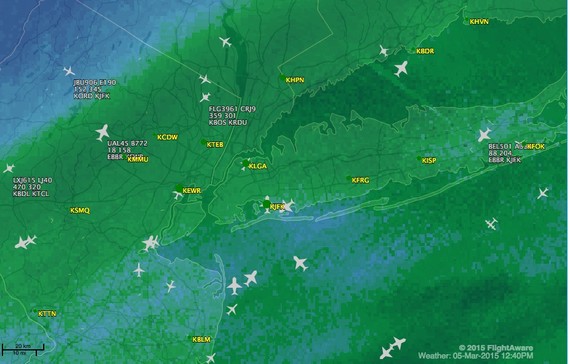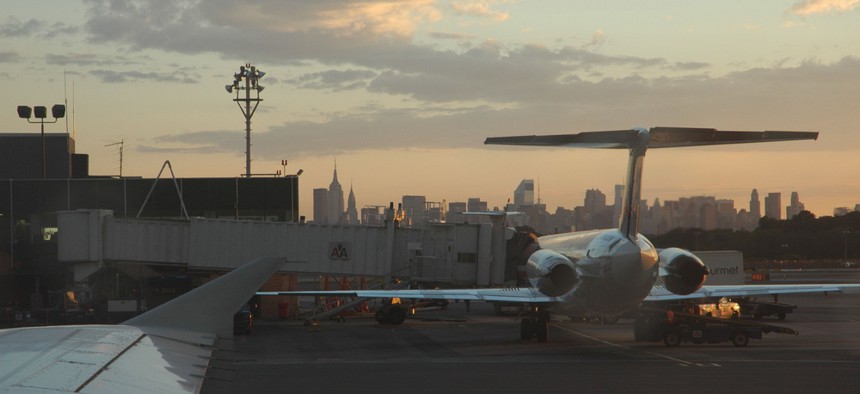How Air-Traffic Controllers Sound When They Have to Close the Airport
Since most things about the modern airline experience are so unpleasant for most of the traveling public most of the time, it's worth noticing how smoothly these professionals do their work.
It's obviously good news that no one appears to have been hurt when a Delta Air Lines flight skidded off a runway this morning at LaGuardia airport. Here's an aspect of the whole process I find enlightening:
Reader and aviation buff Ari Ofsevit sent a link to the LiveAtc.net recording of transmissions from the LaGuardia control tower while the episode was underway. It's not embeddable, but you can listen to an MP3 of the recording if you click here . A listener's guide to what you'll hear:
• At about time 2:15, the tower controller clears a different Delta flight, number 1999, to land on Runway 13. The controller also reports that there is a noticeable but by no means hazardous 12-knot crosswind on landing, and that after a recent landing another airliner had reported "braking action good." Getting the wind report is a routine part of the landing process; the "braking action" information would be added only in slippery conditions like these.
Here's the FAA plate showing LaGuardia's layout, with arrows added by me. The red arrow shows the landing path to Runway 13. The blue arrow shows the approximate direction of the wind.

• At around time 2:40, the controller starts calling for the airliner that ran into trouble, Delta 1086, which presumably had just landed. He doesn't get any answer.
• About 30 seconds after that, the shift into emergency mode begins. A ground vehicle, "Car 100," checks in with the tower to say that there's a problem. By time 4:00, or barely one minute after the controller was calmly sequencing planes in for landing, one of the busiest airports in North America, with dozens of airplanes inbound for landing, is immediately ordered closed, as the ground crews try to assess how bad the problems are.
• Over the next few minutes, the tower controller first tells planes in the landing process to "go around," that is to abort their approach and climb away from the airport, and then sequences them to ... wherever else they will end up. The bad weather and flight cancellations today meant that the New York-area airspace was less jammed than normal. Even so, fitting extra traffic, at one minute's notice, into the flow for JFK and Newark (or airports farther away) is no simple feat.

This action continues with some intensity for the next few minutes. You can get a sample starting at 4:45, when another Delta crew checks in with everything-is-normal calmness only to hear that they are not allowed to land.
• At about 5:40, another air crew reports that the disabled Delta 1086 is leaking fuel. The tower controller passes on that info. After that come long periods of radio silence, when the controllers are on the telephones or talking with people other than air crews, and then bursts of instructions to airplanes that were about to take off but can't (for instance, around time 15:00 and 20:45), sending inbound airplanes somewhere else (and out of one another's way), and managing the turn-on-a-dime closure of this normally very busy terminal.
***
Why do I mention this? One reason is that real-time responses to crisis are just plain interesting—and you can enjoy the drama with clear conscience in a case like this, in which (apparently) no one was hurt. But the major reason is to emphasize a point that my wife Deb wrote about here , and that most air travelers never get a chance to witness. That is the remarkable unflappability of air-traffic controllers in circumstances that would leave most people very flapped.
When this LaGuardia controller first hears that the active runway is closed, and then that the entire airport has been closed, his voice rises in pitch. But at that moment he has no way of knowing whether this was a minor mishap or whether a planeload of people had just died on impact. He goes on to juggle a complete re-ordering of plans very quickly and in relative calm. Compared with the way most people in most roles handle the unexpected, air-traffic controllers are amazingly steady—as are the flight crews too. Since most things about modern airline travel are unpleasant for most of the traveling public in most circumstances, it's worth being reminded of how these professionals do their work.
( Image via rthoma / Shutterstock.com )
NEXT STORY: Do the Same Rules Apply to You?





